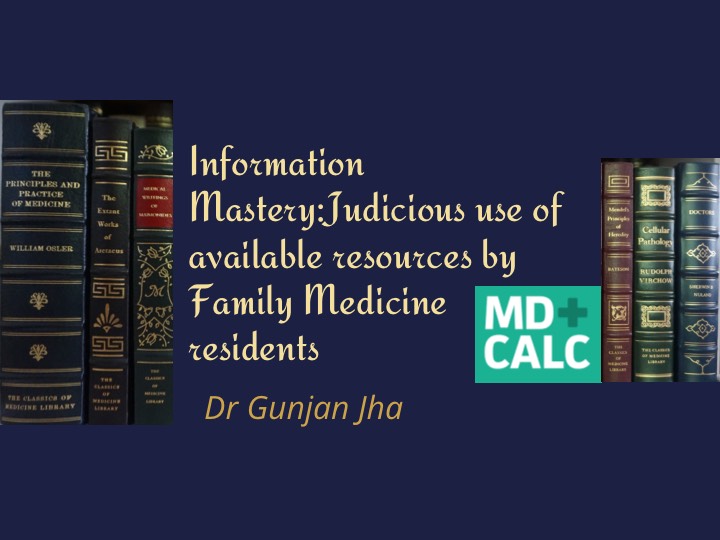


A lucid flow of knowledge from source to seeker has never been as easy as it is today. The concept of ‘Evidence Based Medicine’ (EBM) is a core feature of modern medicine. This approach accepts that there is a hierarchy of evidence and that ‘conclusions’ related from ‘controlled experiments’ are accorded greater credibility than conclusions grounded in other sorts of evidence. To gain access to the most verified, authentic and evolving data we turn towards an ever expanding sea of journals. The medical literature expands with the publication of roughly 75 journals and 11 systematic reviews daily. Therefore here we need to understand that evidence based medicine is a tool to support high quality clinical practice and not to substitute the shared-decision making process followed by the healthcare team.
As a decision maker we need to understand that not all information resources are of equal value. In assessing information resources, one needs to consider the relevance and validity of the information provided, the work involved in answering one’s question and the transparency of their process. Backdrop of their study, sample population, time frame and the year of study all contribute towards the relevance of information.
I. Determine if the clinical questions we are generating are background or foreground questions. Match the question type to the best information resource for the question.
Types of questions :
1. Background questions – who , what, where, when, why and how of anything – complete blueprint of disease / medication / procedure. Eg: definition, classification, scoring, types , list of causes or side effects – factual data.
2. Foreground questions – ask for specific case oriented information Eg: Is this herpes zoster or irritant contact dermatitis? Is this acute or chronic kidney injury? Which is the best one for my patient? Blood transfusion/ Fresh frozen plasma/ IV fluid/ IV Iron
II. Another critical method for filtering information is to identify the orientation of the information resource. The evidence can be patient or disease oriented.
Patient – oriented evidence – it measures outcome that patients care about – symptoms, time taken to relieve symptoms, morbidity or mortality.
Disease – oriented evidence – it measures outcomes that are markers of disease such as blood pressure, peak flow, bacteriological cure, serum creatinine levels etc.
A family physician must come across these tools with a vision of his own. One must familiarize themselves with different point – of – care resources and how to incorporate them in their work. The key to make healthcare of a country more efficient is to strengthen the tools of frontline caregivers. The primary care physician is responsible to create a strong mesh of network at the grass-root level, thereby enabling proper support, triaging, and referral systems for continuity of care and coordinated care. The concept of family medicine practice is guided by 9 basic principles –
With changing times our roles are getting broadened and more challenging and the significance of these core values cannot be more emphasised. Medical practice in collaboration with artificial intelligence is the future and hence it's even more important that we raise the GenNext of family physicians equipped with judicious use of EBM. The residents in particular are going through a learning curve. A habit inculcated at this level will go a long way in increasing accordance with new age medical protocols. Text books have been the center stage throughout for theoretical and clinical knowledge. Access to the internet has brought Pubmed, Wiley's library and all the journals to our fingertips. Knowing the right sources of information is extremely important and time effective. Keeping books and journals in our pocket makes learning spontaneous and instant. While clinical decision making needs background, foreground and some pondering; there are some nuggets we need to use while managing patients. Such as alternate medicine names, checking out the composition of a new drug, side effects, dosage, scoring for a disease and so on. This is where some amazing medical apps come into play. I have been impressed by a few and so would like to enlist them here:
1) CIMS India - exhaustive compilation of medicines available in India. Dosage, cost of medicines, safety in pregnancy, and alternatives are available. Quite handy when a patient gives weird names while recalling what medication he is taking at home.
2) Epocrates - it's popular in the USA and keeps the database significant for them. Still the pharmacological discussion in it is praiseworthy and can be used on the basis of interest.
3) Slides share - this app is more of a compilation of all the presentations being prepared around us. When short of time it helps in checking out a topic quickly.
4) MDCalc - it has all the guidelines, scorings and more. You have to literally check this out to know what you have been missing.
5) Medical books - well if you can't carry heavy books to the workplace this one should help. Most of the basic books are available here, new editions and free for download.
Being well informed is being half prepared. All the decision making and how we act upon it depends entirely upon what we know. Specifically in today's time when a pandemic has brought the whole world to its knees just because we don't know much about it and are so, not much prepared for it. As doctors our superpower will always be our knowledge. Let's work towards creating better channels of learning and growing.
Dr Gunjan Jha
Final year resident, DNB Family Medicine
Fortis hospital Noida
89gunj@gmail.com

| YOUNG DOCTORS MOVEMENT |STATE LEADERS | FMPC 2019 | FMPC 2020
| AFPI
© All rights reserved 2020. Spice Route India 2020
Contact us at TheSpiceRouteIndia@gmail.com